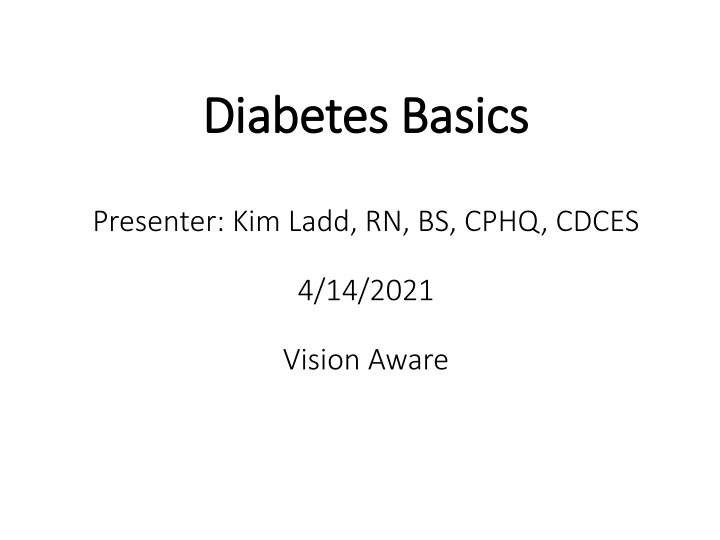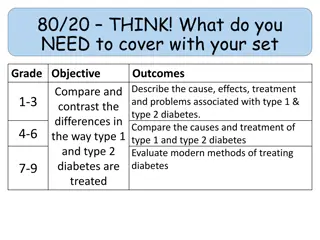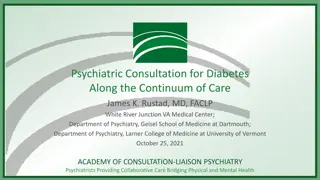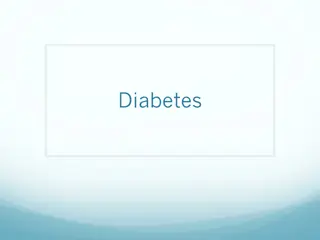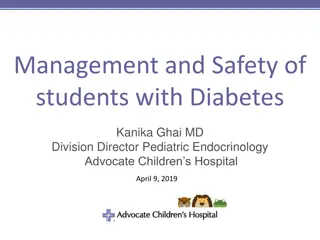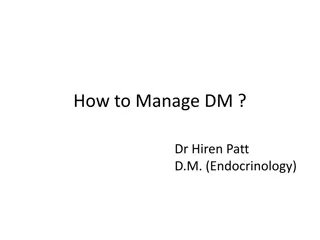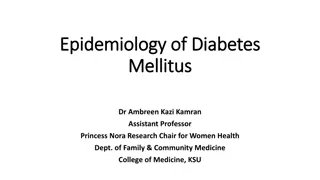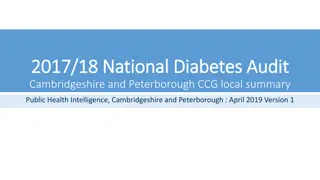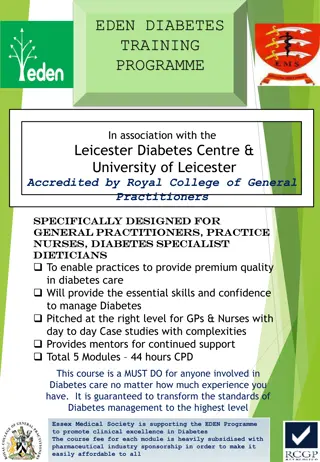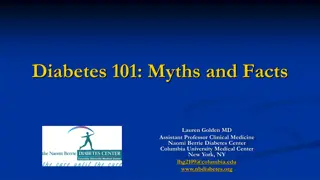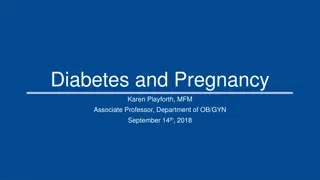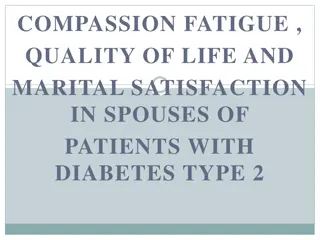- Diabetes Basics & Management: Understanding Symptoms and Types
Diabetes Basics and Management webinar covers the symptoms, types, and diagnosis of diabetes including prediabetes. Learn about the chronic disorder of carbohydrate metabolism, diabetes mellitus, and its impact. Explore the autoimmune disease Type 1 diabetes, lifestyle control for Type 2 diabetes, and gestational diabetes. Understand prediabetes as a warning sign for increased risk of diabetes and cardiovascular disease. Discover ways to manage blood sugar levels and prevent complications related to vision loss.
Download Presentation

Please find below an Image/Link to download the presentation.
The content on the website is provided AS IS for your information and personal use only. It may not be sold, licensed, or shared on other websites without obtaining consent from the author.If you encounter any issues during the download, it is possible that the publisher has removed the file from their server.
You are allowed to download the files provided on this website for personal or commercial use, subject to the condition that they are used lawfully. All files are the property of their respective owners.
The content on the website is provided AS IS for your information and personal use only. It may not be sold, licensed, or shared on other websites without obtaining consent from the author.
E N D
Presentation Transcript
Diabetes Basics Diabetes Basics Presenter: Kim Ladd, RN, BS, CPHQ, CDCES 4/14/2021 Vision Aware
Diabetes Basics Diabetes Basics This webinar is designed to provide the participant with a basic understanding of diabetes, how to manage blood sugar levels to prevent diabetes complications including vision loss, and the availability of accessible resources for people with diabetes and low/no vision. Objectives: 1. Be able to articulate what diabetes is and 3 ways to control it. 2. Apply knowledge gained to improve diabetes management and prevent complications. 3. Locate and utilize accessible resources on diabetes to improve knowledge base.
Diabetes Mellitus Definition Diabetes Mellitus Definition The name diabetes mellitus refers to these symptoms: diabetes, from the Greek diabainein, meaning to pass through, describes the copious urination, and mellitus, from the Latin meaning sweetened with honey, refers to sugar in the urine.
Diabetes Mellitus Definition Diabetes Mellitus Definition A chronic disorder of carbohydrate metabolism resulting from inadequate production or utilization of insulin. With diabetes, your pancreas either doesn't make enough insulin or your body can't use its own insulin effectively.
Types Types of of Diabetes Diabetes: : Type 1: an autoimmune disease that attacks the pancreas resulting in the inability of the pancreas to make insulin; must take insulin every day. Type 2: the body does not make or use insulin well; controlled by diet, exercise, pills and/or insulin. Gestational diabetes: develops in the 24th- 26thweek of pregnancy. Other: latent autoimmune diabetes in adults (LADA), neonatal diabetes and maturity onset diabetes of the young (MODY)
Prediabetes Prediabetes A term used for individuals whose glucose levels do not meet the criteria for diabetes, but whose levels are too high to be considered normal. Should be viewed as a warning sign that you are at an increased risk for diabetes and cardiovascular disease.
How is Diabetes Diagnosed? How is Diabetes Diagnosed? Symptom assessment by doctor Lab tests: Fasting Glucose Test Normal: Less than 100 mg/dcl Pre-diabetes: 100-125 mg/dcl Diabetes: 126 mg/dcl or higher Random (anytime) Glucose Test Normal: Less than 140 mg/dcl Pre-diabetes: 140-199 mg/dcl Diabetes: 200 mg/dcl or higher A1c Test Normal: Less than 5.7% Pre-diabetes: 5.7 - 6.4% Diabetes: 6.5% or higher 2020 CDC Statistics: 34.2 million Americans just over 1 in 10 have diabetes 88 million American adults approximately 1 in 3 have prediabetes
Prediabetes Prediabetes Lab Values Lab Values HgbA1c of 5.7%- 6.4% Fasting blood sugar levels of 100-125 mg/dcl According to the CDC, an estimated 33.9% of U.S. adults aged 18 years or older (84.1 million people) had prediabetes in 2015, based on their fasting glucose or A1C level. Nearly half (48.3%) of adults aged 65 years or older had prediabetes
Symptoms Symptoms of of Diabetes Diabetes Frequent urination Excessive thirst Unexplained weight loss Extreme hunger Sudden vision changes Tingling or numbness in hands or feet Feeling very tired much of the time Very dry skin Sores that are slow to heal More infections than usual If you think you might have diabetes, visit your physician for testing as soon as possible.
Why is Why is Maintaining Blood Sugar Levels Maintaining Blood Sugar Levels So Important So Important? ? To Prevent Complications The cornerstone of diabetes management is to maintain blood sugar levels to prevent complications. It is the complications of diabetes that cause morbidity and mortality.
How Does Diabetes Cause Complications? How Does Diabetes Cause Complications? Sugar is an irritant in the bloodstream. When it stays in the bloodstream because you do not have enough insulin to move it into your cells, it causes damage to blood vessels and nerves which leads to organ, muscle, and cell damage. Controlling Your Diabetes = Preventing Complications
Complications of Complications of Diabetes Diabetes cardiovascular disease diabetic eye disease slow-healing wounds infections of the kidneys, skin, bladder bladder dysfunction gum disease & gum infections sexual problems kidney failure gastroparesis neuropathy neuropathic pain foot ulcers lower-extremity amputations
Diabetes and the Eyes Diabetes and the Eyes Diabetic eye disease is a group of eye problems that can affect people with diabetes. These conditions include diabetic retinopathy, diabetic macular edema, cataracts, and glaucoma. Over time, diabetes can cause damage to your eyes that can lead to poor vision or even blindness.
Diabetes and the Eyes Diabetes and the Eyes Retinopathy (damage to the blood vessels in the retina in the back of the eye) is the most common eye complication and the most likely to lead to blindness. As the eyes attempt to circulate more blood to compensate for the damaged blood vessels, it forms abnormal and fragile blood vessels that eventually break and leak blood and cloudy fluid. If untreated, this process blurs vision and can eventually lead to blindness. Cataracts (clouding of an eye's lens) Glaucoma (an increase in fluid pressure inside the eye that leads to optic nerve damage and loss of vision)
D Diabetes Also Increases Your Risk Of: iabetes Also Increases Your Risk Of: cancer of the liver, pancreas, bladder, endometrium, colon, rectum, and breast foot ulcers dementia hearing impairments fatty liver disease pancreatitis psychosocial/emotional disorders (anxiety, depression, eating disorders, schizophrenia) type 1 increases risk of other autoimmune diseases (celiac, thyroid, adrenal insufficiency, myasthenia gravis, gastritis, autoimmune hepatitis)
How Do You Know If Your How Do You Know If Your Diabetes Is Controlled? Diabetes Is Controlled?
HgbA1C Levels and Goals HgbA1C Levels and Goals Blood test performed at a doctor s office or a lab Measures average blood glucose level over the previous three months A1C goal for most people with diabetes is below 7% to prevent complications >=6.5% diabetes 5.7% - 6.4% prediabetes <5.7% normal
Blood Sugar Levels and Goals Blood Sugar Levels and Goals Testing blood sugar levels at home with a glucometer provides a snapshot of diabetes management and provides data for understanding what and how food, activity, medicine, and lifestyle affect blood sugar levels. 80- 130 mg/dl fasting and between meals <180 mg/dl 2 hrs after meals >180 mg/dl is too high (hyperglycemia) <70 mg/dl is too low (hypoglycemia)
When you keep your blood sugar level When you keep your blood sugar level close to normal you are more likely to: close to normal you are more likely to: have more energy less tired less thirsty urinate less often heal better have fewer skin or bladder infections have fewer problems with your eyesight, feet, and gums
Low Blood Sugar Low Blood Sugar (less than 70 mg/dcl) and and High Blood Sugar High Blood Sugar (higher than 180 mg/dcl) Levels Levels
Causes of Hypoglycemia Causes of Hypoglycemia (low blood sugar) (low blood sugar) Taking too much insulin or diabetes medication Not eating enough Postponing or skipping a meal or snack Increasing exercise or physical activity without eating more or adjusting your medications Drinking alcohol
Symptoms of Hypoglycemia Symptoms of Hypoglycemia (low blood sugar) (low blood sugar) Early signs and symptoms of diabetic hypoglycemia include: Shakiness, Dizziness, Sweating, Hunger, Irritability or Moodiness, Anxiety or Nervousness, Headache If diabetic hypoglycemia goes untreated, signs and symptoms of severe hypoglycemia can occur. These include: Clumsiness or Jerky movements, Muscle Weakness, Difficulty Speaking or Slurred Speech, Blurry or Double vision, Drowsiness, Confusion, Convulsions or Seizures, Unconsciousness, Death
How How To Treat Low Blood Sugar To Treat Low Blood Sugar 1. Consume 15-20 grams of glucose or simple carbohydrates (ex. 3 glucose tablets, 4 oz of juice or regular soda, 1 tbsp of sugar or honey, 8 oz of milk, 2 tbsp of raisins, hard candy). 2. Recheck blood glucose level after 15 minutes. 3. If hypoglycemia continues, repeat steps 1 and 2 up to 3 times. 4. Once blood glucose returns to normal, eat a small snack if next planned meal or snack is more than an hour or two away.
Symptoms of Hyperglycemia (high Symptoms of Hyperglycemia (high blood sugar) blood sugar) Early signs and symptoms: Recognizing early signs and symptoms of hyperglycemia can help you treat the condition promptly. Watch for: Frequent Urination, Increased Thirst, Blurred Vision, Fatigue, Headache Later signs and symptoms: If hyperglycemia goes untreated, it can cause toxic acids (ketones) to build up in your blood and urine (ketoacidosis). Signs and symptoms include: Fruity-smelling Breath, Nausea and Vomiting, Shortness of Breath, Dry Mouth, Weakness, Confusion, Coma, Abdominal Pain Treatment: Insulin and Supportive Care
Causes of Hyperglycemia Causes of Hyperglycemia (high blood sugar) (high blood sugar) Not using enough insulin or oral diabetes medication Not injecting insulin properly or using expired insulin Not following your diabetes eating plan Being inactive Having an illness or infection Using certain medications, such as steroids Being injured or having surgery Experiencing emotional stress, such as family conflict or workplace challenges
People with diabetes, should get an influenza (flu) vaccination every fall. People with diabetes (type 1, type 2, or gestational), even when well-managed, are at high risk of serious flu complications, including pneumonia and bronchitis. Flu can also make it harder to manage your blood sugar levels. Flu may cause your blood sugar to rise, but it may drop if you lose your appetite and don t eat. It s important to check your blood sugar regularly when you re sick.
Connection Between Diabetes Connection Between Diabetes and C Coronavirus oronavirus and According to the CDC, older adults and people of any age who have serious underlying medical conditions might be at higher risk for severe illness from COVID-19, particularly if not well controlled, including: chronic lung disease or moderate to severe asthma serious heart conditions immunocompromised severe obesity (body mass index [BMI] of 40 or higher) chronic kidney disease undergoing dialysis liver disease diabetes
Connection Between Diabetes Connection Between Diabetes and C Coronavirus oronavirus and Diabetes does not make you more susceptible to catching coronavirus, BUT if you catch coronavirus, you will most likely suffer from more serious symptoms. WHY?
Connection Between Diabetes Connection Between Diabetes and Coronavirus/Infections Coronavirus/Infections and People with diabetes are more susceptible to developing infections because high blood sugar levels weaken your immune system defenses. (Hyperglycemia is thought to cause dysfunction of the immune response, which results in failure to control the spread of invading pathogens.) Any illness raises blood sugar levels and uncontrolled diabetes increases your susceptibility to severe illness. Your body spends a lot of energy fighting diabetes so it is less equipped to fight off another threat. Many people with diabetes have heart disease, heart failure, are overweight and/or have kidney failure. The more diabetes complications you have exponentially increases your chance of getting a severe illness.
Diabetes Diabetes Management Tips Management Tips Make a commitment to manage your diabetes Don t smoke (1-800-QUIT-NOW) Visit your doctor every 6 months for a diabetes check-up Take care of your teeth Keep your vaccinations up to date Pay attention to your feet Establish a daily routine Practice stress management and get enough sleep Take medications as prescribed by doctor Test blood glucose levels at home as ordered by your doctor Exercise regularly (at least 150 minutes each week) Healthy eating (balance, moderation, and portion control). Join future Vision Aware Webinars to learn more about these tips
Accessible RESOURCES Sulli the Diabetes Guru On Alexa and Google Assistant Ready to answer your questions about diabetes, including condition, diet, exercise, medication, and monitoring https://www.accu-chek.com/resources/sulli- the-diabetes-guru Diabetes Apps (see list)
